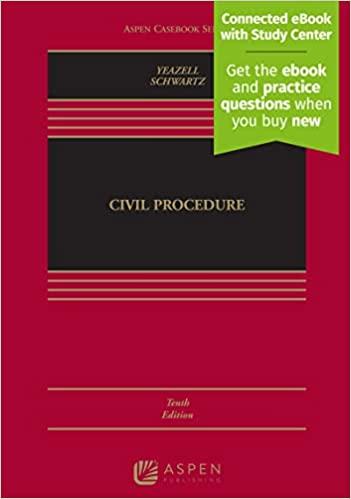Question
11. The greatest percentage share of the U.S. securities market is held by -- a. Retail investors b. Institutional investors c. Mutual funds d. Sovereign
11. The greatest percentage share of the U.S. securities market is held by --
a. Retail investors
b. Institutional investors
c. Mutual funds
d. Sovereign wealth funds
12. Which of the following is NOT a "Securities Law"?
a. Investment Company Act of 1940
b. Williams Act
c. Sherman Act
d. Public Utility Holding Company Act of 1935
13. The Sarbanes-Oxley Act was adopted in the wake of the ENRON and Worldcom
scandals to -
a. Regulate derivatives
b. Reduce auditor conflicts of interests
c. Regulate mortgage-backed securities
d. Establish the CFTC
14. A law suit brought under Section 12(a)(2) of the Securities Act on behalf of
many investors in a security --
a. Must allege that each investor read and relied on a false or misleading
statement
b. May never be filed more than a year after the securities offering
c. May recover only rescission damages
d. May be certified as an investor class action
15. The "Howey Test" --
a. Determines whether a fact is material
b. Determines who may be liable for a securities violation
c. Determines what is an investment contract
d. Determines whether a market is "efficient"
16. Which of the following is probably NOT a "security"?
a. A limited partnership interest
b. An interest rate swap
c. A Treasury bond
d. An LLC member interest
17. Bernie Madoff's business plan --
a. Was churning
b. Was to front run his clients
c. Was a pay for order flow scheme
d. Was a Ponzi scheme
18. A possible future event --
a. Must always be disclosed as a forward-looking statement
b. Must be disclosed if material
c. May be material if likely to occur
d. May never be disclosed in a registration statement
19. Under Section 5 of the Securities Act, an issuer may not sell securities --
a. Until a registration statement is effective
b. Until a registration statement is filed
c. Within 20 of filing a registration statement
d. Until a "red herring" is delivered
20. Under Regulation D --
a. An issuer can raise an unlimited amount of capital
b. An issuer can sell securities to no more than 100 "accredited" investors in
any twelve-month period
c. An issuer may sell securities only to accredited investors
d. An issuer can accelerate effectiveness of its registration statement
Step by Step Solution
There are 3 Steps involved in it
Step: 1

Get Instant Access to Expert-Tailored Solutions
See step-by-step solutions with expert insights and AI powered tools for academic success
Step: 2

Step: 3

Ace Your Homework with AI
Get the answers you need in no time with our AI-driven, step-by-step assistance
Get Started


